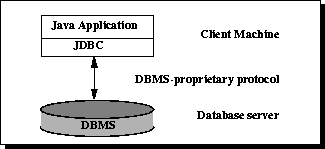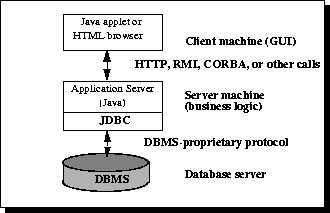JDBC Architecture
By: Sunitha in JDBC Tutorials on 2007-03-15
Two-tier and Three-tier Processing Models
The JDBC API supports both two-tier and three-tier processing models for database access.
Figure 1: Two-tier Architecture for Data Access.

In the two-tier model, a Java applet or application talks directly to the data source. This requires a JDBC driver that can communicate with the particular data source being accessed. A user's commands are delivered to the database or other data source, and the results of those statements are sent back to the user. The data source may be located on another machine to which the user is connected via a network. This is referred to as a client/server configuration, with the user's machine as the client, and the machine housing the data source as the server. The network can be an intranet, which, for example, connects employees within a corporation, or it can be the Internet.
In the three-tier model, commands are sent to a "middle tier" of services, which then sends the commands to the data source. The data source processes the commands and sends the results back to the middle tier, which then sends them to the user. MIS directors find the three-tier model very attractive because the middle tier makes it possible to maintain control over access and the kinds of updates that can be made to corporate data. Another advantage is that it simplifies the deployment of applications. Finally, in many cases, the three-tier architecture can provide performance advantages.
Figure 2: Three-tier Architecture for Data Access.

Until recently, the middle tier has often been written in languages such as C or C++, which offer fast performance. However, with the introduction of optimizing compilers that translate Java bytecode into efficient machine-specific code and technologies such as Enterprise JavaBeans , the Java platform is fast becoming the standard platform for middle-tier development. This is a big plus, making it possible to take advantage of Java's robustness, multithreading, and security features.
With enterprises increasingly using the Java programming language for writing server code, the JDBC API is being used more and more in the middle tier of a three-tier architecture. Some of the features that make JDBC a server technology are its support for connection pooling, distributed transactions, and disconnected rowsets. The JDBC API is also what allows access to a data source from a Java middle tier.
Add Comment
This policy contains information about your privacy. By posting, you are declaring that you understand this policy:
- Your name, rating, website address, town, country, state and comment will be publicly displayed if entered.
- Aside from the data entered into these form fields, other stored data about your comment will include:
- Your IP address (not displayed)
- The time/date of your submission (displayed)
- Your email address will not be shared. It is collected for only two reasons:
- Administrative purposes, should a need to contact you arise.
- To inform you of new comments, should you subscribe to receive notifications.
- A cookie may be set on your computer. This is used to remember your inputs. It will expire by itself.
This policy is subject to change at any time and without notice.
These terms and conditions contain rules about posting comments. By submitting a comment, you are declaring that you agree with these rules:
- Although the administrator will attempt to moderate comments, it is impossible for every comment to have been moderated at any given time.
- You acknowledge that all comments express the views and opinions of the original author and not those of the administrator.
- You agree not to post any material which is knowingly false, obscene, hateful, threatening, harassing or invasive of a person's privacy.
- The administrator has the right to edit, move or remove any comment for any reason and without notice.
Failure to comply with these rules may result in being banned from submitting further comments.
These terms and conditions are subject to change at any time and without notice.
- Data Science
- Android
- React Native
- AJAX
- ASP.net
- C
- C++
- C#
- Cocoa
- Cloud Computing
- HTML5
- Java
- Javascript
- JSF
- JSP
- J2ME
- Java Beans
- EJB
- JDBC
- Linux
- Mac OS X
- iPhone
- MySQL
- Office 365
- Perl
- PHP
- Python
- Ruby
- VB.net
- Hibernate
- Struts
- SAP
- Trends
- Tech Reviews
- WebServices
- XML
- Certification
- Interview
categories
Related Tutorials
Data Access Technologies in Java
JDBC and Tomcat context settings
TEXT datatype SPLIT in MSSQL - to solve the 8000 limit set by varchar
What is Referential Integrity in databases?
Handling CSV in Stored Procedures
java.lang.NoClassDefFoundError and java.lang.NoSuchMethodError
Calling a Stored Procedure from JDBC in Java
setSavepoint and releaseSavepoint Example in Java
Result Sets, Cursors and Transactions in SQL
Stored Procedures example in SQL
Using the DriverManager Class vs Using a DataSource Object for a connection
Comments